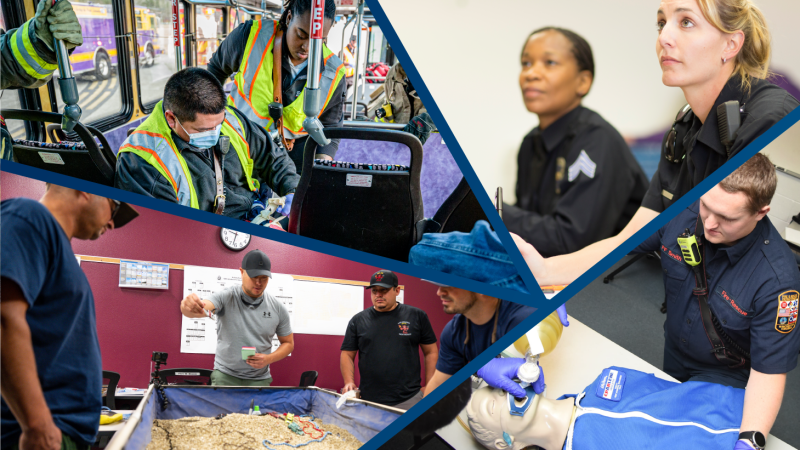Training and Exercises

Implementing effective training and exercise programs to practice communications interoperability is essential for ensuring that the technology works and responders are able to effectively communicate during emergencies.
Highlighted Resource:
Hotwash (10-4) Comment Card
Developed by the NCSWIC Planning, Training, and Exercise Committee with support from Statewide Interoperability Coordinators (SWICs), the Hotwash (10-4) Comment Card assists fellow SWICs in enhancing the feedback, challenges, and lessons learned from trainings and exercises.
This quick, easy to use development tool can improve your organization’s resiliency and preparations for the next disaster. The document was developed directly from emergency communications professionals’ experiences.
Guides
Human Factors Resource Guide (.pdf, 121.08 KB)
Developed by the NCSWIC Planning, Training, and Exercise Committee with support from CISA, the Human Factors Resource Guide provides tools and resources to assist telecommunicators in preparing for the mental stress of their jobs.
Checklist for Communications Technology in Training and Exercises (.pdf, 209.6 KB)
The Checklist for Communications Technology in Training and Exercises assists SWICs who are considering incorporating new and emerging technologies into trainings and exercises. The guide details planning and evaluation considerations when using new communications technology in a training or exercise. The document was populated directly from emergency communications professionals’ experiences.
Planning, Training, and Exercise Resource Guide (.pdf, 156.75 KB)
The Planning, Training, and Exercise Resource Guide presents information and guidelines on how to plan, design, and conduct interoperable communications-specific training and exercise programs.
SWIC-to-STO Engagement Guide (.pdf, 138.15 KB)
Developed by the National Council of Statewide Interoperability Coordinators (NCSWIC), the SWIC-to-STO Engagement Guide supports Statewide Interoperability Coordinators (SWICs) in navigating their relationships with their State Training Officers (STOs) by providing benefits of and best practices for collaboration. Synthesized from the collective knowledge of the NCSWIC membership, the document is best for SWICs with little-to-no association with their STO.
Leveraging the PACE Plan in an Emergency Communications Ecosystem (.pdf, 226.86 KB)
Developed by the NCSWIC Planning, Training, and Exercise Committee with support from Statewide Interoperability Coordinators (SWICs) and Emergency Communications Coordinators (ECCs), Leveraging the PACE Plan in an Emergency Communications Ecosystem assists in establishing and practicing the Primary, Alternate, Contingency, Emergency (PACE) communication plan to plan for critical communications in out-of-the-ordinary situations.
Developing and practicing your PACE will help improve your organization’s resiliency and preparations for the next disaster. The document was developed directly from emergency communications professionals’ experiences.
Webinar Presentations
Georgia's Communications Exercise Webinar Summary (.pdf, 311.37 KB)
This webinar summary focuses on the design, planning, methodologies, and implementation of Georgia’s May 2015 mobile communication vehicle functional exercise.
State of New Jersey COMU Accreditation Program (.pdf, 154.5 KB)
This webinar presentation focuses on the design, planning, methodologies, and implementation of New Jersey’s Communications Unit (COMU) Accreditation Program.
Additional Resources
Communication Unit Training Resources
Documents and videos supporting the Emergency Communications Division's training courses.
Third-Party Evaluators for Training and Exercises (.pdf, 296.75 KB)
Developed by the NCSWIC Planning, Training, and Exercise Committee with support from CISA, Third-Party Evaluators for Training and Exercises assists SWICs when considering using a third-party evaluator in a training or exercise. The document shares potential advantages and challenges as well as other considerations. The document was populated directly from emergency communications professionals’ experiences.
Training and Exercises in the New Normal (.pdf, 329.26 KB)
Developed by the NCSWIC Planning, Training, and Exercise Committee with support from CISA, Training and Exercises in the New Normal assists SWICs in anticipating challenges and finding solutions to continue to ensure high-quality and effective communications-based training and exercises despite budget constraints and in-person limitations. The document was populated directly from emergency communications professionals’ experiences and contains resources, best practices, success stories, and even gaps and challenges.
NCSWIC Emergency Communication Centers Discussion Cards (.pdf, 1.62 KB)
The National Council of Statewide Interoperability Coordinators (NCSWIC) created these flash cards to foster short discussions for Emergency Communication Center staff, supervisors, and administrators to strengthen knowledge of standard operating procedures, refresh on training objectives, and be better prepared to maintain interoperable communications and serve the community.
The Set Your PACE Flyer (.pdf, 2.87 MB)
The Set Your PACE flyer is a resource to promote practicing and developing Primary, Alternate, Contingency, and Emergency (PACE) Plans. The flyer features a QR code that links to another National Council of Statewide Interoperability Coordinators (NCSWIC) Planning, Training, and Exercise Committee product, Leveraging the PACE Plan into the Emergency Communications Ecosystem, which provides a deeper understanding of the importance of the PACE plan.
For even more resources visit SAFECOM Resources, SAFECOM Technology, or the SAFECOM homepage.






